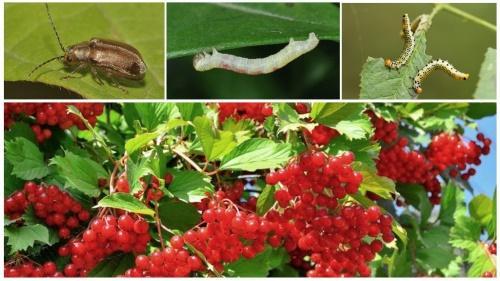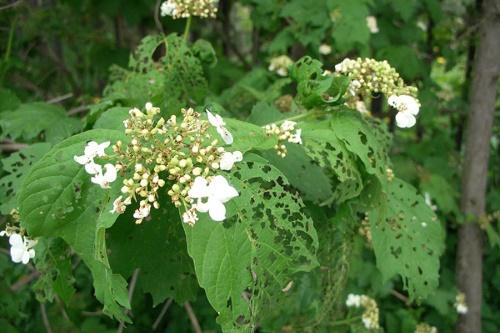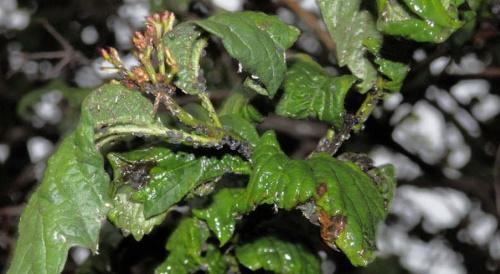Viburnum pests or how to recognize who is chewing on your bush
 Not only apples, pears, raspberries or strawberries suffer from pests. Even decorative crops, such as viburnum, are not protected from the attack of various caterpillars, butterflies and other insects that like to feast on juicy leaves. Viburnum pests not only spoil its appearance. In addition to bitten leaves, these unwanted guests eat young shoots and flower ovary. If you do not take action, then during the season the plant lags far behind in development, the yield of medicinal berries decreases significantly. And, having successfully overwintered and multiplied, the next year the insects continue to be active and can completely destroy the bush.
Not only apples, pears, raspberries or strawberries suffer from pests. Even decorative crops, such as viburnum, are not protected from the attack of various caterpillars, butterflies and other insects that like to feast on juicy leaves. Viburnum pests not only spoil its appearance. In addition to bitten leaves, these unwanted guests eat young shoots and flower ovary. If you do not take action, then during the season the plant lags far behind in development, the yield of medicinal berries decreases significantly. And, having successfully overwintered and multiplied, the next year the insects continue to be active and can completely destroy the bush.
Viburnum pests - who attacks the bush most often

So, who loves Kalina the most? These are pests such as:
- aphids, especially black;
- viburnum leaf roll;
- cap moth;
- viburnum leaf beetle.
Now let's take a closer look at how to identify insects, what they are and how to deal with them.
Black aphid

Larvae are the greatest danger - small brown, almost black bugs. They settle on young shoots, drink juice, and eat tender young foliage. As a result, the latter dries and curls up, and the branches themselves bend. Then, adults with wings hatch from the larvae. They fly to neighboring plants and lay eggs in the bark and on the shoots. In the spring, new bugs hatch from them and everything repeats.
The massive attack of aphids begins in the spring, in the month of May. It is at this time that the bush must be processed. And most of all she lays eggs in young growth, so she needs to be cut out periodically.
Control measures:
- In early spring, before the buds bloom, spray the bush with folk remedies. These include infusions of plants with a strong aroma: celandine, wormwood, needles. This treatment can be done once a week until the aphids disappear.
- In case of mass defeat, insecticides will be needed: biological (Fitoverm, Intavir) or chemical (Fufanon, Karbofos).
Kalina leaf roll
 The leafworm itself is a gray butterfly, but its larvae and caterpillars also cause harm. Gray or olive, they begin their "work" in early spring, eating the buds. When leaves appear, caterpillars eat them too, and also weave whole nests, fastening them with cobwebs. They look like lumps, and inside the larvae pupate and a butterfly is born.
The leafworm itself is a gray butterfly, but its larvae and caterpillars also cause harm. Gray or olive, they begin their "work" in early spring, eating the buds. When leaves appear, caterpillars eat them too, and also weave whole nests, fastening them with cobwebs. They look like lumps, and inside the larvae pupate and a butterfly is born.
Caterpillars are gluttonous and in a short time only bare branches can remain from the viburnum.
Control measures:
- Before the foliage appears, treat the viburnum with Nitrofen (60% paste).
- When the leaves bloom, repeat the treatment, replacing the paste with Karbofos.
- If there are a lot of caterpillars in the summer, spray the Decis bush twice with a break of two weeks.
You can prevent the multiplication of leaf rollers by collecting and destroying its nests (along with leaves).
Cap moth
 A small light gray butterfly with shiny wings feeds on viburnum leaves and lays orange larvae. She winters well under the bark.
A small light gray butterfly with shiny wings feeds on viburnum leaves and lays orange larvae. She winters well under the bark.
The most effective against moths are special preparations with which it is better to treat the bush in the spring. These include:
- Intavir;
- Fufanon;
- Actellic.
Viburnum leaf beetle
 It is a beautiful and fairly large brown beetle. The problem is that both he and his larvae bring harm. The beetle lays eggs in young twigs, from which larvae similar to worms hatch. Caterpillars in the spring settle on the back of the leaf and begin to actively eat it, leaving only a net. In June, caterpillars descend to the ground and transform into beetles in the soil. They again climb the bush, and gnaw holes in the leaves, already dwelling on the upper side of the plate. When the foliage runs out, the beetles even eat the buds.
It is a beautiful and fairly large brown beetle. The problem is that both he and his larvae bring harm. The beetle lays eggs in young twigs, from which larvae similar to worms hatch. Caterpillars in the spring settle on the back of the leaf and begin to actively eat it, leaving only a net. In June, caterpillars descend to the ground and transform into beetles in the soil. They again climb the bush, and gnaw holes in the leaves, already dwelling on the upper side of the plate. When the foliage runs out, the beetles even eat the buds.
Damp weather favors active reproduction of the beetle.
Control measures:
- In autumn, cut out damaged and dry shoots, remove the foliage on which the eggs are laid.
- In early spring, treat the viburnum with Intavir, repeating the procedure after 10 days.
- During the summer, periodically spray the plant with herbal infusion.